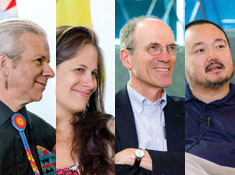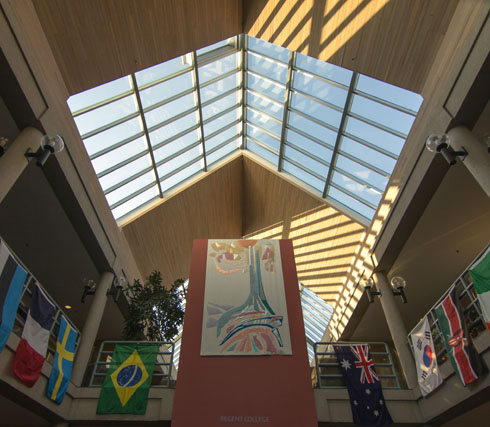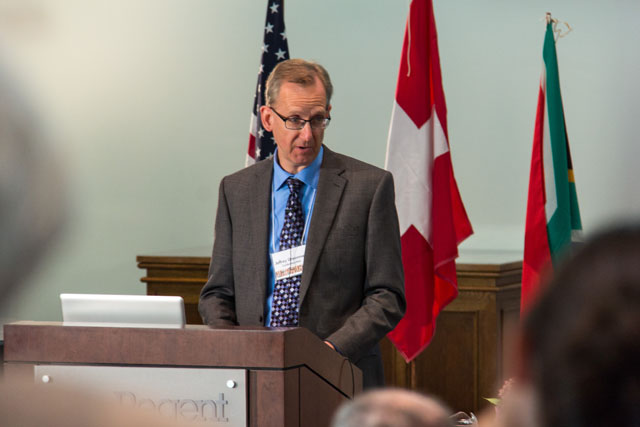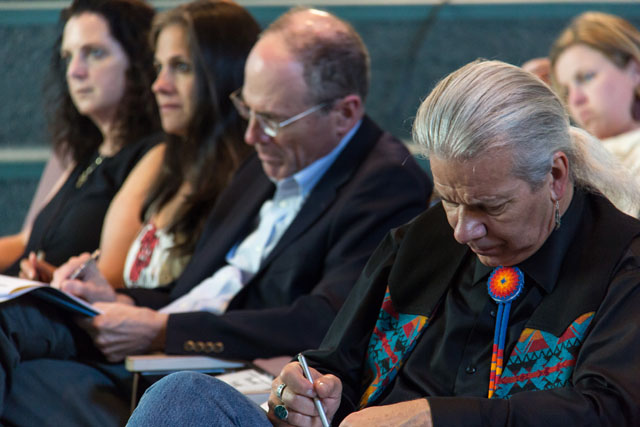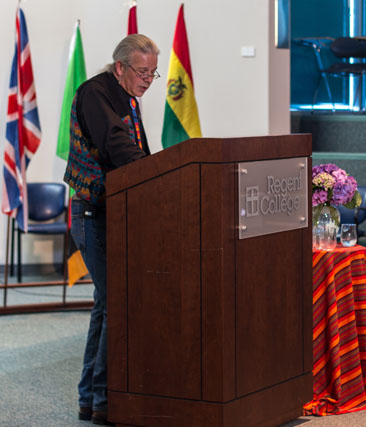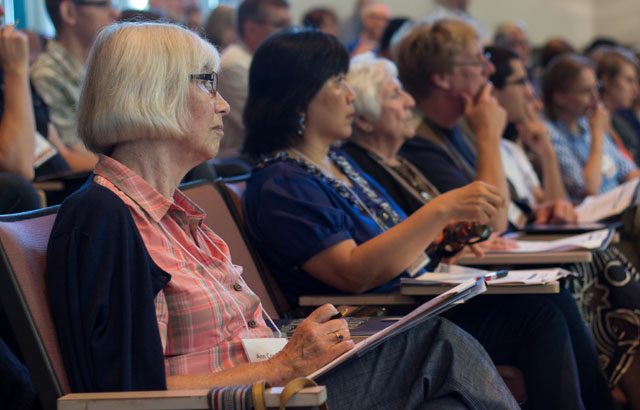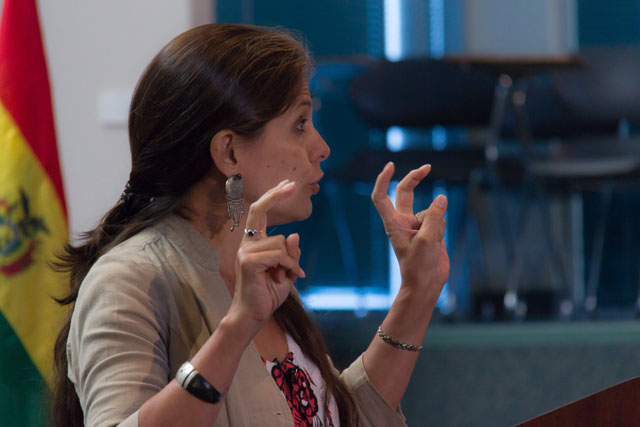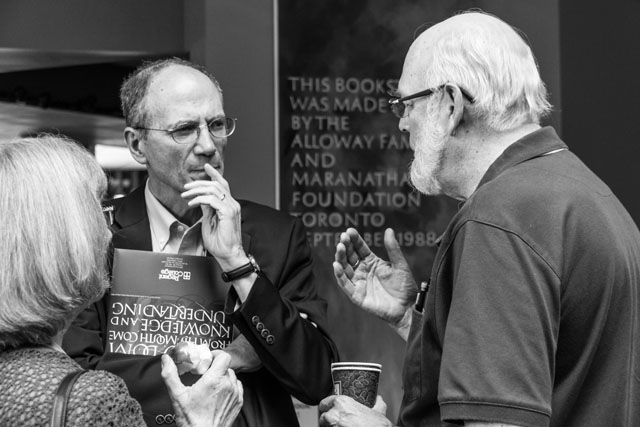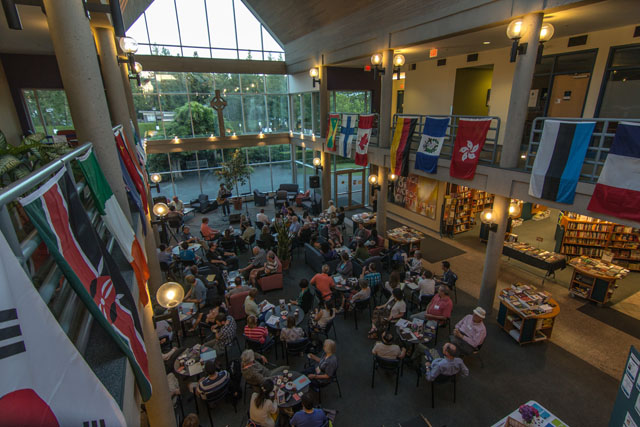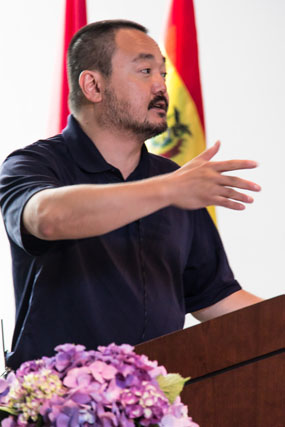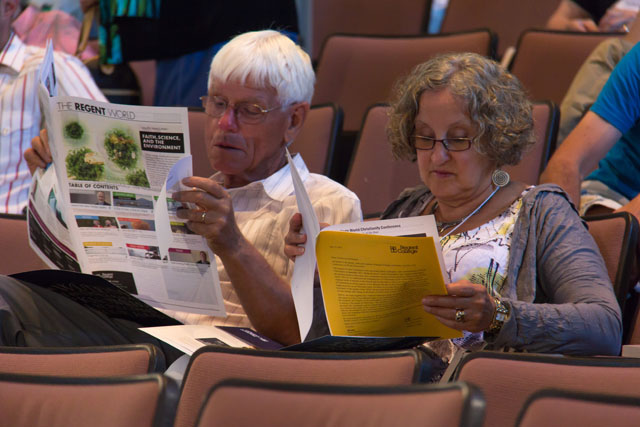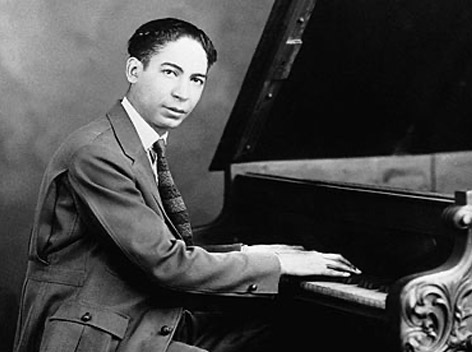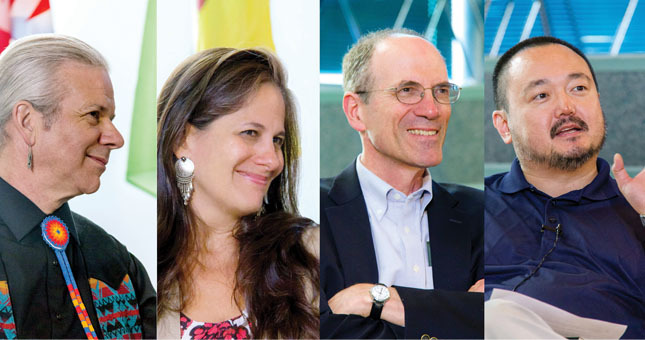
Duncan Ris
A Meeting of Maps
Notes from the World Christianity Conference
It starts with a map. Each of us comes from specific physical, cultural, emotional, and mental places. We carry around these “maps” of who we are, and as we journey through life, we inevitably encounter other people’s maps. The World Christianity conference at Regent College July 19-20 could be considered a meeting of maps in all senses of the word. Participants as local as Vancouver and as far away as Hong Kong, New Zealand, and Brazil attended the conference hosted by Diane Stinton and Jeffrey Greenman.
The panel of speakers included scholars and practitioners from different geographies and cultural backgrounds: Andrew Walls (in absentia), Research Professor at Africa International University’s Centre for World Christianity; Mark Noll, Professor of History at the University of Notre Dame; Terry LeBlanc, a Mi’kmaq/Acadian and Director of My People International and NAIITS (North American Institute for Indigenous Theological Studies), Ruth Padilla DeBorst, Director of Christian Formation and Leadership Development with World Vision International in Latin America; and Soong-Chan Rah, Associate Professor of Church Growth and Evangelism at North Park Theological Seminary in Chicago.
Andrew Walls’ term “The Ephesian Moment” characterized the collegial tone of the conference—the social coming together of two people or cultures to experience Christ. It occurred with the Jews and Gentiles in the early church, and it is occurring again “in a richer mode than has ever happened since the first century.” Walls continued via a recorded video: “None of us can reach Christ’s completion on our own. We need each other’s vision to help complete it.”
Yet how exactly we help one another become more complete Christ-followers is neither a simple answer nor an easy journey. Nevertheless, the World Christianity conference provided an example of where to start—in dialogue. Diverse members of the body of Christ came together to share stories of what God is doing in different parts of the world, to encourage and challenge one another in light of the changing nature of Christianity, and to reflect on what these stories mean for our own expression of faith.
Understanding our Maps
Andrew Walls’ opening presentation read by Jeff Greenman used the analogy of maps to describe worldviews and how they work. Worldviews, like maps, are complicated. They contain many markings, not only related to the phenomenal world that we see and touch, but also related to religion, society, morality, ranks and hierarchies, ideas of belonging, and more. A God component often appears on our maps, but he is smaller on some peoples’ and bigger on others’. There is no single “Christian worldview” because everyone has a different past. Rather, multiple Christian worldviews exist, some which may even share operational features with those of Buddhists or Muslims.
Understanding how worldviews work helps us understand the way we do missions. When people are converted to Christianity, their old map doesn’t get erased and replaced by a new map. Rather, points get added to their map. Perhaps Christ appears for the first time, or maybe he gets bigger, but the old points don’t disappear. Some may stay in exactly the same place, like witchcraft or sorcery. Conversion is literally a “turning around” of what’s already there towards Christ. As Walls stated, it’s less about the content than it is about the direction. The Protestant missionary movement of the early twentieth century brought an Enlightenment map to places like Africa whose own cartography revealed deficiencies in the Western theological tradition. How do Western maps address dreams and visions, family and ancestors, or an answer for evil? Walls concluded that while Western theology is not necessarily wrong, it is too small for Africa and for most of the world grappling with points that don’t show up on Western maps.
The Changing Face of Christianity
As the centre of Christianity shifts from the West to the Global South and East, the need to reframe how we think and do theology emerges as a pertinent undertaking for our own spiritual formation, our church communities, and our witness to the world. Mark Noll’s paper discussed the North American factor in world Christian history. While at the start of the twentieth century, North American missionaries took the lead in cross-cultural promotion of the gospel, in recent decades, many formerly mission-receiving countries like South Korea are now sending more missionaries per population than traditional missionary-sending countries like the United States. Noll summarized, “Christian mission has shifted from the West going to the rest [of the world] to a pattern of believers going from everywhere to everywhere.”
With this proliferation of cross-cultural mission work, a rich exchange lies waiting between North American Christianity and what Noll calls “post-Christendom world Christianity” flourishing today in many parts of Asia, Africa, and Latin America. One example is learning the balance between the individual and the community. While North America’s emphasis on the individual has been the key to much energy, dedication, and sacrifice spurring on evangelistic efforts, church formation, and mission, outsiders ask if egotism and schisms are the costs of such individual focus. In contrast, many non-Western societies better practice the communal nature of Christian faith and theology, yet sometimes to the extent that the individual becomes eclipsed by the group. In the end, Noll maintained an essential place in Christianity for individuals who are “renewed in the depths of their personal being in love and service to God” without destroying the communion of saints.
In his talk “Looking Towards the Next Evangelicalism,” Soong-Chan Rah showed via PowerPoint images that the literal face of Christianity has changed from white, middle-aged men living in an American suburb in the 1950s to a peasant woman in Nigeria or a teenager living in Seoul or Mexico City today. The multiethnic composition of twenty-first-century Christianity is undeniable, even within North America. Rather than what some fear as the de-Christianization of America because of immigrant populations who come with religiously pluralistic backgrounds, statistics show that multiethnic churches are alive and thriving in America while predominantly white congregations have declined. This change is more accurately characterized as the de-Europeanization of American Christianity, to use Stephen Warner’s words. The growth of the Korean-American church is a case in point, with many Korean immigrants already Christians before coming to America, and if not, converting to Christianity shortly after arriving.
In speaking about how to move forward, Rah acknowledged that while churches should aim for the biblical picture of diversity, forced integration is not the answer since it would likely lead to racial separation again in a number of years. Rather, a range of possibilities should exist along the spectrum of ethnic to multiethnic church. Additionally, while many churches are ethnically diverse on a global scale, the parish scale doesn’t really reflect this diversity yet. Rah suggested some ways to begin changing this picture at the local level: by having diversity in our denominational leadership, by listening to marginalized voices (such as those of women, seniors, and immigrants), and by finding and declaring our own voice even if that voice has an accent or lacks the humour and charisma of a twenty-nine year-old hipster pastor.
Remapping the Story
While much of the conference looked ahead to the implications of world Christianity, Terry LeBlanc’s and Ruth Padilla DeBorst’s presentations travelled back to the past in order to show how history impacts present reality. “The first time global Christianity came to our door wasn’t a good experience,” LeBlanc began. Western missionaries attempted to erase the map of Indigenous people. As one of his NAIITS co-workers said who grew up in a church-run residential school, “There I learned another people’s language, culture, and history as if my own didn’t exist.” The Old Testament was never translated for Native North Americans and, as a result, LeBlanc stated, “It’s difficult to connect with narratives that aren’t your own.” The Indigenous community has a rich pre-contact history that LeBlanc encouraged Westerners to get to know if they want to create a better relationship with Indigenous people. After all, if we believe God is the omnipresent Creator, he created Indigenous culture and was present in their communities before the Europeans “found” them.
LeBlanc’s work with NAIITS attempts to remap the gospel narrative to connect with Indigenous experience by drawing on the strengths of their community rather than importing a Western model of education. These strengths include the role of orality and story (rather than propositional, truth-based approaches), the re-embracing of community, and an integrative theology that doesn’t compartmentalize physical and spiritual spheres.
Similarly, Padilla DeBorst talked about the need for a practical, holistic theology that integrates all of life. Informal theological education has grown rapidly in Latin America where theology is done in community “for the sake of the life and mission of the church.” Western theological schools often separate hermeneutics from New or Old Testament studies, ethics, missiology, and church history, but the Two-Thirds World hasn’t had the luxury to develop all these disciplines. The curriculum she helped design with the Latin American Theological Fellowship and taught by the Centro de Estudios Teologicos Interdisciplinarios (Center for Interdisciplinary Theological Studies) is organized around society, family, work, and church—where faith meets real life. The Bible is full of story, she said, but we often feel the need to abstract meaning from these stories, organize them, and then apply these ideas to real life. The ideas become so abstracted that they end up distancing us from real life.
Given her emphasis on story, it was fitting that Padilla DeBorst’s presentation mapped two narratives of Christianity over five centuries of Latin American church history: the God of Empire, of religious patriotism and institutionalized Christianity, and the God of the weathered face—the suffering servant who cared for the poor and gave his life away. While the imperial God thirsted for wealth and military conquest, bringing foreign people in as slaves and turning local people into slaves, missionaries of the God of the weathered face sought peaceful cohabitation with Latino people and defended the dignity of all, including the weak and oppressed. Padilla DeBorst extended the same challenge to us: which gospel, which God, and which story do we inhabit when we encounter others—a story of capitalist progress and power, or a story of humility and justice that cares for the marginalized in our midst?
Journeying Together
The panel discussion at the end returned to Walls’ statement that we need each other’s vision to reach Christ’s completion, offering suggestions of what this could look like. For LeBlanc, it was a call to enter Indigenous communities as a learner. Learn their history so mistakes from the past don’t get repeated. Additionally, he admonished us not to do short-term missions. “What we need is long-term relationships.”
In answer to what’s necessary for the re-evangelizing of the ailing West by the Global South, Padilla DeBorst pointed out that the language shouldn’t be that of “I have something to teach you” so that the South becomes the new North, but that we all have something to learn. The essential difference lies in our attitude and posture—coming with open hands and gathering together around the dinner table to share in true communion with each other and with Christ.
Rah echoed this familial picture of the body of Christ. Our language of hospitality often goes something like, “I’ll invite you over and tolerate your kimchi for an hour or so, but then you leave my home.” No, if we’re truly family, we move in together, smelly kimchi and all. We do life together because we are not sufficient unto ourselves. All we can offer one another is different interpretations of the same show, like different seats around a theatre, Rah continued. Everyone is watching the same thing, but from different (world) views. Sharing these views with one another enriches our own.
This call to share, learn, dine, and commune is essentially a call to humility. Perhaps this humility was no better displayed than in Noll’s response of how to respond to churches in parts of the Majority World that draw heavily from the prosperity gospel. Prosperity can look different in different contexts, he answered. Prosperity in the West might be driving a Porsche, but in the Global South or East, it might be having three meals a day. Rah added to this, challenging us to think about how much we ourselves have bought into the prosperity gospel with the latest technology and multimedia presentations in Western churches.
Discussion like this reiterated the need for all cultures to be reflective and repentant before God because none of us have it right but we all have each other to help broaden, challenge, and focus our maps as we pursue Christ together.
